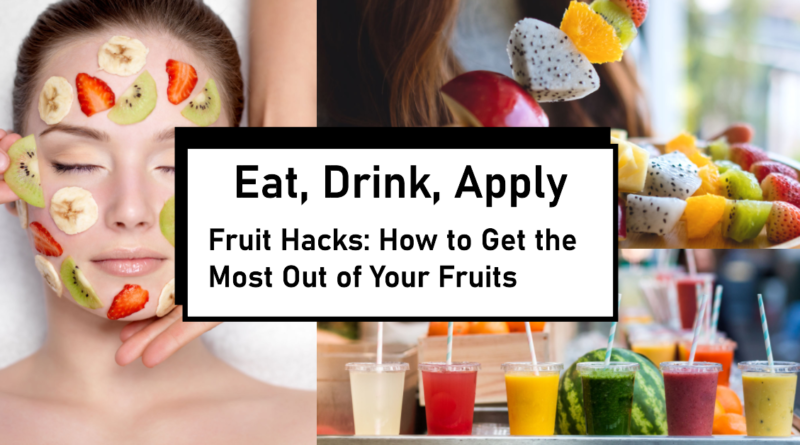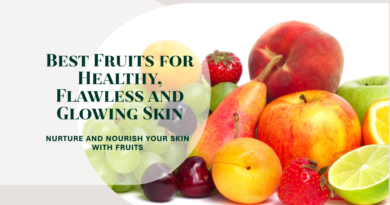Eat, Drink, or Apply? Decoding the Fruits’ Path for for a Healthier You with Nutritionists
In a world where health trends come and go, one dietary constant remains undeniable: the invaluable benefits of fruits. Packed with essential vitamins, minerals, fiber, and antioxidants, fruits have long been celebrated as nature’s nutritional powerhouses. However, as nutritional science advances and our understanding of the human body deepens, the methods of consuming fruits have expanded beyond just eating them whole. Welcome to a blog that delves into the fascinating world of fruits and explores the age-old question: should you eat them, drink them, or apply them?
When and How to eat your fruits for maximum benefits?
Amid the bustling aisles of supermarkets and the ever-expanding array of fruit-based products, it’s easy to get lost in the choices available. The journey to a healthier lifestyle often begins with a quest for clarity—understanding which path to take when it comes to incorporating fruits into your daily routine. This blog aims to be your guiding light, backed by the insights of experienced nutritionists who have dedicated their careers to unraveling the mysteries of optimal nutrition
We’ll begin our exploration by tracing the journey of fruits from orchard to table. Beyond their vibrant colors and tempting aromas, fruits hide a treasure trove of nutrients that play vital roles in supporting bodily functions. Nutritionists will help us decode the nutritional profiles of various fruits, shedding light on the vitamins and minerals they contain, the health benefits they offer, and how these nutrients interact with our bodies.
To Eat or Not to Eat: The ‘Whole Fruit’ Dilemma
Eating whole fruits is undoubtedly a classic way to enjoy their goodness. From the satisfying crunch of apples to the juiciness of oranges, the act of consuming fruits in their natural state offers more than just nourishment—it’s a multisensory experience. But are there instances where eating whole fruits might not be the best choice? Our experts will weigh the pros and cons, offering insights into sugar content, glycemic index, and how whole fruits contribute to our daily calorie intake.
The Rise of Fruit-based Beverages- Sip by Sip
The rise of smoothies, juices, and fruit-infused waters has given us alternative avenues to reap the benefits of fruits. Nutritionists will decipher the differences between gulping down a glass of fruit juice and relishing the whole fruit. What happens to the fiber content when fruits are juiced? How can you make the healthiest choices when it comes to fruit-based beverages? These are the questions we’ll address to help you make informed decisions.
Beyond the Rind, Topical Fruit Applications
The world of skincare and beauty products has embraced the natural goodness of fruits. From avocado face masks to citrus-infused serums, the trend of applying fruits topically has gained traction. But does slathering on fruit extracts deliver the same benefits as consuming them internally? Our experts will delve into the science of skincare, explaining benefits of fruits for skin care and how to make the most of topical applications.
Peeling Back the Truth: Debunking Fruit Myths
Myths and misconceptions about fruits have proliferated over time. Do certain fruits really have “negative” calories? Can you eat as much fruit as you want without worrying about weight gain? Our nutritionists will debunk prevalent fruit-related myths, providing evidence-based insights to help you make informed choices.
Pigments and Nutritional Value of Fruits
Fruits come adorned with a rainbow of vibrant pigments, each color indicating a unique set of nutrients that contribute to our well-being. Whether we eat, drink, or apply them, these pigments hold the key to unlocking a variety of health benefits of fruits. Let’s explore the spectrum of pigments and their nutritional value, backed by scientific data and expert insights.
- Anthocyanins: The Deep Reds and Purples
Found in berries like blueberries, strawberries, and cherries, as well as in red grapes, anthocyanins are potent antioxidants responsible for the rich hues of deep red and purple fruits. When consumed, these compounds have been linked to reducing the risk of chronic diseases such as cardiovascular issues, diabetes, and even cognitive decline. A study conducted by the Harvard T.H. Chan School of Public Health showed that higher anthocyanin intake was associated with a reduced risk of heart attack.
- Carotenoids: The Lively Oranges and Yellows
Carotenoids, such as beta-carotene, give fruits like mangoes, apricots, and oranges their inviting orange and yellow tones. Beta-carotene, a precursor to vitamin A, supports healthy vision, immune function, and skin health. For instance, a medium-sized mango can provide more than 50% of the daily recommended intake of vitamin A, contributing to the maintenance of good vision and a robust immune system.
- Lycopene: The Radiant Reds
Lycopene is responsible for the bright red color of tomatoes, watermelons, and pink grapefruits. This pigment is renowned for its potential to combat oxidative stress and reduce the risk of certain cancers, particularly prostate cancer. Research published in the journal “Cancer Epidemiology, Biomarkers & Prevention” indicated that higher lycopene intake was associated with a reduced risk of aggressive prostate cancer.
- Chlorophyll: The Green Elixir
While chlorophyll gives fruits like kiwi, green apples, and grapes their verdant color, it’s also a powerhouse of health benefits. Rich in vitamins, minerals, and antioxidants, chlorophyll supports detoxification, aids digestion, and promotes skin health. Additionally, the chlorophyll in green fruits like kiwi has been associated with improved gastrointestinal health and reduced inflammation.
- Flavonoids: The Assorted Hues of Health
Flavonoids encompass a range of pigments found in fruits like citrus fruits (oranges, lemons), apples, and grapes. These compounds have anti-inflammatory and antioxidant properties, contributing to heart health and potentially reducing the risk of certain cancers. The Nurses’ Health Study demonstrated that a higher intake of flavonoid-rich foods was associated with a reduced risk of cardiovascular disease in women.
- Eat, Drink, or Apply: Harnessing the Power of Pigments
Whether you choose to eat, drink, or apply fruits, you can harness the power of these pigments for your health. Eating whole fruits provides a balance of fiber, vitamins, and minerals that contribute to overall well-being. Juicing can deliver a concentrated dose of nutrients, though it may reduce fiber content. Applying fruit-based products and soaps topically can offer skin benefits through the absorption of antioxidants and vitamins.
The pigments in fruits are more than just eye-catching—they represent a spectrum of health-promoting compounds. So, the next time you bite into a juicy strawberry, savor a glass of freshly squeezed orange juice, or apply a berry-infused face mask, remember that you’re not just indulging your senses, but also nurturing your body with a vibrant palette of nutrients.
Optimal Times to Consume Your Fruits for Maximum Benefits as Timing Matters

Let’s delve into the optimal times to consume fruits and how timing can enhance benefits of fruits, supported by scientific data and expert insights.
- Kickstarting Your Day with Morning Marvels
Eating fruits in the morning can set a positive tone for the rest of the day. The natural sugars found in fruits provide a quick source of energy to jumpstart your metabolism and fuel your activities. Additionally, the fiber content in many fruits can help regulate your digestion and prevent blood sugar spikes.
A study published in the “British Journal of Nutrition” highlighted that consuming fruits in the morning led to improved satiety and reduced calorie intake throughout the day, potentially aiding weight management.
- Fueling Your Exercise Routine with Pre-Workout Power
If you’re planning to hit the gym or engage in physical activity, consuming fruits about 30 minutes to an hour before your workout can provide you with a valuable energy boost. The carbohydrates in fruits serve as readily available fuel for your muscles, enhancing your endurance and performance during exercise.
A study in the “Journal of the International Society of Sports Nutrition” found that consuming fruits before exercise improved exercise performance and reduced muscle soreness in participants.
- Snack Sensibly Curb Midday Cravings
When those midday cravings strike, reaching for a piece of fruit can be a smart choice. Fruits are nutrient-dense and satisfying, making them an ideal snack option. Their fiber content helps keep you full and supports steady blood sugar levels, preventing energy crashes.
Research published in the “Journal of the American College of Nutrition” demonstrated that consuming fruits as a snack was associated with improved diet quality and reduced risk of obesity.
- Post-Workout Recovery for Repair and Replenish
After a workout, your body enters a recovery phase where it repairs muscle tissue and replenishes glycogen stores. Consuming fruits that are rich in carbohydrates and antioxidants can aid in this recovery process. The sugars in fruits help restore glycogen levels, while antioxidants combat oxidative stress induced by exercise.
A study published in the “Journal of the International Society of Sports Nutrition” indicated that consuming fruits after exercise enhanced muscle glycogen recovery and reduced markers of muscle damage.
- Before Bed Elegance with Nighttime Indulgence
While it’s generally recommended to consume most of your fruits earlier in the day, there are exceptions. Certain fruits like kiwi and cherries contain compounds that may support sleep quality. These fruits provide a natural source of melatonin, a hormone that regulates sleep-wake cycles.
A study in the “Journal of Medicinal Food” revealed that consuming kiwi before bedtime was associated with improved sleep onset, duration, and efficiency in adults with sleep disturbances.
A quick recap: Timing Tips for Fruit Consumption
- Morning: Enjoy fruits to kickstart your day with energy and fiber.
- Pre-Workout: Fuel your exercise routine with a fruit-based snack.
- Snacking: Choose fruits for satisfying, nutrient-dense snacks.
- Post-Workout: Aid recovery by consuming fruits rich in carbohydrates and antioxidants.
- Before Bed: Opt for sleep-enhancing fruits like kiwi and cherries.
By aligning your fruit consumption with these optimal times, you can maximize the benefits of fruits to your overall health, energy levels, and well-being. Remember that variety is key—enjoy a colorful assortment of fruits throughout your day to provide your body with a broad range of essential nutrients.
Final Words
In the intricate tapestry of nutrition and wellness, fruits stand as vibrant threads that weave health and vitality into our lives. From the orchard to our tables, from morning till night, and whether we eat, drink, or apply them, fruits offer a spectrum of benefits that can elevate our well-being. As you savor the next juicy bite, relish the refreshing sip, or embrace the nurturing touch, remember that the world of fruits holds a treasure trove of nourishment and wonder, waiting to be explored for a healthier and happier you.


